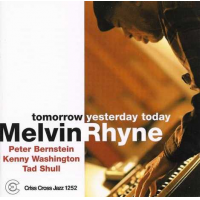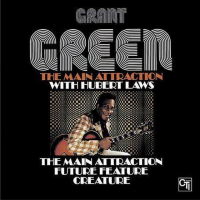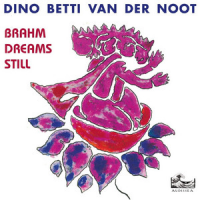Home » Jazz Articles » Liner Notes » Riccardo Arrighini: Cambio di Marcia
Riccardo Arrighini: Cambio di Marcia
But in 2006 I heard Arrighini again at the "Top Italian Jazz" presentation at Birdland in New York in April and at the big Umbria festival in Perugia in July (both times with Cafiso), and I began to understand that something special was going on. Then, in addition to the live appearances, there were his recordings. With exposure to his albums over time, it became possible to hear the elegant complexity of Arrighini's ideas, and how they tied, and I became a believer. For an artist just 40 who got a relatively late start, he has already compiled a large body of recorded work, mostly on Paolo Piangiarelli's Philology label. To cite just one example from Arrighini's discography, his series dedicated to the music of Antonio Carlos Jobim (in four "chapters") is the most comprehensive investigation of the great composer's music ever undertaken by anyone other than Jobim himself. Arrighini was born in 1967 in Viareggio. Like so many of the Italian pianists now making an impact on the international jazz scene, his early formal education was entirely in classical music. He studied with private instructors from the age of seven and graduated from the L. Boccherini Conservatory in Lucca. When asked what happened to suddenly redirect him to jazz at the age of 24, he instantly replies, "Oscar Peterson." Arrighini threw himself into jazz studies, working with major Italian pianists Enrico Pieranunzi and Stefano Battaglia, and making two trips to the United States to spend two semesters at the Berklee College Of Music in Boston.
His years of classical training and his passionate internalization of the jazz language have resulted in a unique alchemy. Many piano players have been awed by Oscar Peterson. Very few have the chops to truly follow Peterson's inspiration wherever it leads. Arrighini has the chops.
"Voci Di Massaciuccoli," the first track of his new album, Cambio Di Marcia, reveals that his technique has deepened and he has also matured as an artist. His speed and precision now serve to express the contents of his soul. Arrighini the composer creates a nucleus of pristine melody and Arrighini the improvising pianist builds it outward for almost eleven minutes, encountering many shifting tides of emotion, all related to his love for Massaciuccoli, the beautiful region of Tuscany that is his home. As a bandleader, Arrighini has put together a new ensemble with Stefano Bagnoli on drums (his long-time associate in Francesco Cafiso's quartet) and Riccardo Fioravanti on bass. It is already one of the most creative, intuitive, interactive piano trios in jazz. It reveals why the piano trio has been called "the minimum complete jazz orchestra."
"Leaving" is another piece based on Arrighini's love for a place—in this case Brazil. The emotions are bittersweet because it was written on a plane, flying home. It is another composition that reveals Arrighini's gift as a melodist. (All the great piano trios have had a fully articulate second solo voice in the bassist: Scott LaFaro for Bill Evans, Gary Peacock for Keith Jarrett, Marc Johnson for Enrico Pieranunzi. Arrighini's trio has Riccardo Fioravanti, and he is a poet of the first order.)
"La Canzone Di Stefy" is another love song, this time not for a place but a person, Arrighini's wife. Its sweetness never cloys because its melodic grace is both fresh and firm.
Even Arrighini's edgier, more liberated concepts remain lyrical. The title track eventually arrives at a 6/8 meter, and along the way "changes gears" for real, both up and down—but smoothly, like a Lamborghini sequential-shift transmission. "Mad Tune" does not sound crazy. Its radical mix of harmonies and jazz and operatic melodies is made to flow.
Which is perhaps the most important point about Riccardo Arrighini. His sophisticated musical mind is comfortable with complexity: the satirical summing up of a century of music in "Satie-ra," the rhythmic diversity of "Tune 4 Us." But this trio always makes everything flow—even "La Canzone Di Matteo Franz," a song about the unpredictable spontaneous energy of a toddler (Arrighini's son). It becomes a much gentler version of a love song when its melody is revisited in a "ghost track" at the end of the album. It is a luminous solo piano piece, simultaneously a homage to Bill Evans (who also had a piano solo like a carillon at the end of his album Intuition) and a lullaby like a carillon for Matteo Franz.
To the list of world-class jazz pianists who have come out of Italy—a list, which includes artists like Enrico Pieranunzi and Stefano Bollani and Danilo Rea and Stefano Battaglia and Antonello Salis—must now be added the name of Riccardo Arrighini.
Liner Notes copyright © 2026 Thomas Conrad.
Cambio di Marcia can be purchased here.
Contact Thomas Conrad at All About Jazz.
Thomas travels frequently writing about jazz outside the borders of the United States.
Track Listing
Voci Di Massaciuccoli; Tune For Us; Leaving; La Canzone Di Matteo Fran; Lazy Moanin'; Cambio Di Marcia; Mad Tune; Satie - Ra; La Ballata Di Stefy.
Personnel
Album information
Title: Cambio di Marcia | Year Released: 2007 | Record Label: Incipit Records
Tags
PREVIOUS / NEXT
Support All About Jazz
 All About Jazz has been a pillar of jazz since 1995, championing it as an art form and, more importantly, supporting the musicians who make it. Our enduring commitment has made "AAJ" one of the most culturally important websites of its kind, read by hundreds of thousands of fans, musicians and industry figures every month.
All About Jazz has been a pillar of jazz since 1995, championing it as an art form and, more importantly, supporting the musicians who make it. Our enduring commitment has made "AAJ" one of the most culturally important websites of its kind, read by hundreds of thousands of fans, musicians and industry figures every month.




















